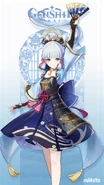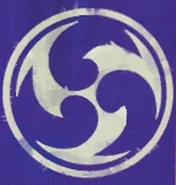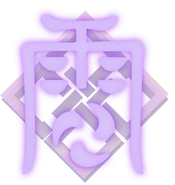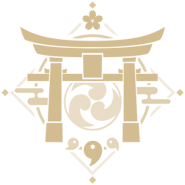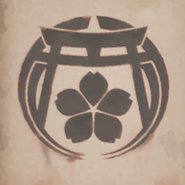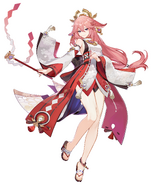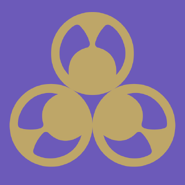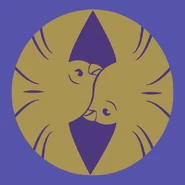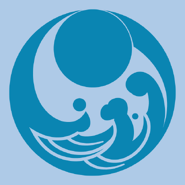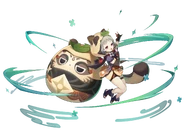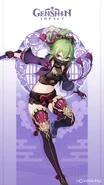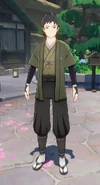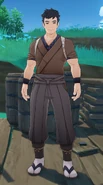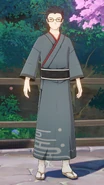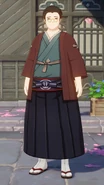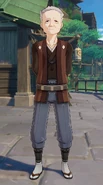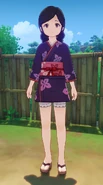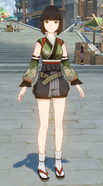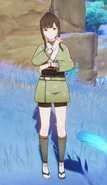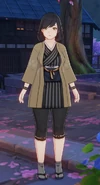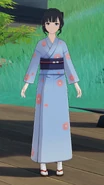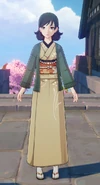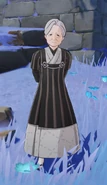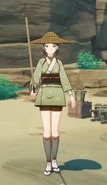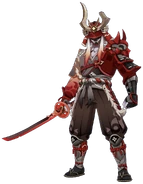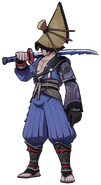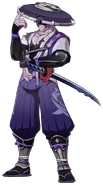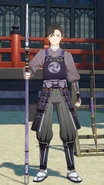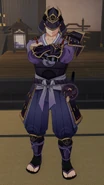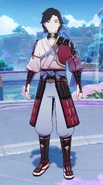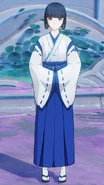The Inazuma archipelago is sub-divided into three main factions: the islands ruled by the Raiden Shogun (Narukami Island, Kannazuka, Yashiori Island, and Seirai Island), Watatsumi Island which worships Orobashi, and Tsurumi Island.
While these islands are all considered part of Inazuma, the geographical and cultural makeup of these areas are vastly different.
Life in Inazuma[]
Life in Inazuma prior to the Ei's Vision Hunt and Sakoku Decree is unknown, but Paimon states that Inazuma did not have any problems the year before she began accompanying the Traveler.[1] After Ei issued her decrees, life in the region took a drastic turn for the worse for all, as available resources in the nation dropped and very few goods were imported in, forcing many businesses to look for alternate methods. The atmosphere in the nation when the two decrees were active was implied to be tense and dangerous,[2] with some smugglers even refusing to bring in items from the nation.[3] Crime is particularly rampant in Inazuma's wilderness, with large numbers of Treasure Hoarders and ronin like Nobushi and Kairagi.
Following the abolishment of the Vision Hunt Decree and expulsion of corrupt officials, life began to slowly improve for the better, although the Sakoku Decree meant that the economy was still struggling. After Ei abolished the Sakoku Decree, Inazumans were able to trade with other nations, host people from other nations and go out to explore themselves.
Inazuma only has one major city and one port; Inazuma City and Ritou respectively. Apart from these urban settings, the rest of the people live in small villages or estates. Some of these villages were abandoned; Seirai Island has no permanent human residents after the island was destroyed by the Thunder Manifestation, while Higi Village and another unnamed village south of it was evacuated after the release of Tatarigami energy on the island. Tsurumi Island, while part of the Inazuma archipelago, is also devoid of people, as its previous civilization was annihilated by Kapatcir.
Bake-Danukis are known to live in Inazuma, who enjoy pranking passersby by pretending to offer food and shelter, disguising it as leaves and mud.[4] While humans are still the most predominant inhabitants of Inazuma, youkai such as tengu, oni and kitsune also reside in Inazuma; however, like the adepti of Liyue, few remain and most live in seclusion.
Inazuman samurai society often revolves around an honor system of sorts; samurai families, being relatively common in Inazuma, have an immense amount of pride and honor, often sending their children to serve in the Shogun's armies to glory and fame. Samurai are known to engage in duels from time to time. They are particularly prideful of their own skills; being bested in battle or duel by another or being helped by an outsider is typically considered to be shameful.[5]
Agriculture[]
Watatsumi Island has historically had very poor soil for growing crops, which was a primary motivating factor for the Narukami-Watatsumi War at the end of the Archon War. According to legend, Enkanomiya is constantly trying to pull the spirit of Watatsumi Island into the depths, causing soil erosion and bleaching that turns it into "Holy Soil." The Watatsumi Mitama Omatsuri is a ritual performed to stave off the spread of Holy Soil. Tsuyuko, a shrine maiden who studied at Sumeru Akademiya, believes that "Holy Soil" is actually caused by the salinity and alkalinity of the seawater encroaching on the island, which leaches nutrients from the soil.[6]
Other islands appear to be having a similar issue, as Konda Village of Narukami Island has difficulty in trying to grow crops.
Many Lavender Melon trees can be found across Inazuma's islands. While Sunsettia and Apple trees cannot be found in Inazuma's overworld, this seems to be a purely gameplay phenomenon: the Expedition reward for Byakko Plain includes Sunsettias, which indicates that Sunsettias can be found in Inazuma's wilds.
Architecture[]
Inazuman buildings and furnishings typically make use of Aralia, Maple, Otogi or Yumemiru Wood. Yumemiru wood is typically used for creating shrines.
Cuisine[]
According to Chongyun, authentic Inazuman cuisine is ice-cold fresh and can take the exhaustion away from a day of hard training.[7] Seafood plays an important role in Inazuman cuisine due to the large ocean surrounding the nation. Other foods include poultry like Imported Poultry, ramen, dango, and egg rolls.
Technology[]
The Maguu Kenki originate from Inazuma. They are magical autonomous puppets that use the powers of Cryo and Anemo, having been created by unknown people to mimic the Iwakura Clan sword arts.
Onmyoudou was also developed in Inazuma by Kamuna Harunosuke. While mostly forgotten, traces of it still exist in legends and by the Kairagi, who utilise shikifuda to elementally infuse their swords despite not having a Vision.
Duels[]
A Duel Before the Throne is a traditional Inazuman duel between two combatants that is fought in Tenshukaku and witnessed by the Shogun.
If someone has a disagreement with another party or feels that they have been slighted in some way, they can challenge the offender to a duel before the throne. The two parties will travel to Tenshukaku and present their case to the Raiden Shogun. If the Shogun gives them the clearance to engage in combat, then they will begin fighting until someone is unable to duel any further. These duels always end in the death of one of the combatants. The loser is either killed by a lethal blow, or if they survive the duel, executed by the Musou no Hitotachi.
Two notable duels have been referenced so far. Kazuha's friend challenged the Raiden Shogun to a duel for instituting the Vision Hunt Decree, and Kujou Sara accepted on her behalf. He ultimately lost the duel and was executed. Later, during Duel Before the Throne in the Omnipresence Over Mortals Archon Quest, the Traveler challenged Signora to a duel in an attempt to stop the Fatui from taking over Inazuma and also as an act of revenge for her stealing Venti's Gnosis. A hard battle was fought, and ultimately, Signora was defeated and executed by the Musou no Hitotachi.
Arts[]
Ikebana[]
Ikebana is the art of arranging flowers to create a floral courtyard. Current known practitioners are Kamisato Ayaka and Fushizome.
Martial Arts[]
There are several martial arts practiced in Inazuma.
Mystic Arts[]
Bladesmithing[]
Inazuma is famous for its bladesmithing techniques. It's fame even allowed them to have a consistent trade with Fontaine to provide the nation their skills. Inazuma had five bladesmithing schools called the Raiden Gokaden, though Scaramouche's machinations have resulted in only one school, the Amenoma School surviving.
Designs, Motifs, and Symbols[]
The following designs, motifs, and symbols are typically seen within Inazuma or on Inazuma-related parties.
Character Cards[]
Inazuma's Character Cards are similar to Mondstadt's: it features one large circle with a smaller circle inside, aligned towards the bottom of the larger circle. Inazuma's Vision shape takes up the top center of the space between the two circles, with five smaller circles on each side.
The bottom three circles' icons are largely the same: the bottommost depicts a sakura or cherry blossom, while the one above it depicts two different kumadori makeup styles used in Kabuki theater. Above that are two opposing animal envoys wearing their corresponding masks: A kitsune wearing a fox mask on the right side and an inugami wearing a dog mask on the left.
Of the remaining four circles, the bottom left one depicts coral and crashing waves, which is possible a reference to Orobashi. Above it is a Shinto shrine with a cherry blossom symbol above it. To the right of the Vision is an icon depicting the Tenshukaku, and below it is an icon of a mitsudomoe with a katana.
Electro Mitsudome[]
The Electro Mitsudome is the symbol that represents the Raiden Shogun and her rule. The Electro symbol is made from the negative space of the three tomoe.
Sakura Flower[]
Five-petaled flowers representing the Sacred Sakura can be found on the buildings of the Grand Narukami Shrine and on Yae Miko's clothing.
Mon[]
In Inazuma, like in Japanese history, clans may have a mon (紋) or seal by which they are identified.
Cloud Motif[]
A traditional way of drawing flat, stylised clouds called yokogumo (横雲).
Economy[]
Book printing is one the main trades in Inazuma, in part due to the Yae Publishing House, who are known throughout Teyvat as the giant in the printing industry. They occasionally host the "This Novel is Amazing!" contest.
Inazuma also produces kimonos, toys and fireworks for export to other nations. The majority of fireworks are manufactured by Naganohara Fireworks, while many renowned kimonos are made by Ogura Textiles & Kimonos. Prior to the Sakoku Decree, Inazuma had a healthy economy, but once it was enacted, exports, imports and internal trade drastically decreased. Very few ships dared to brave the storms surrounding the archipelago, and they often lost many of their goods in the process. Seafood production also declined as the Kanjou Commission saw all vessels as a means of escape. After the decree was repealed, the nation is slowly resuming trade.
Like Liyue, Inazuma also possesses a mining and smithing industry. Jakotsu Mine and the Mikage Furnace are well known in Inazuma, but the former closed after a "sickness" spread throughout the island, while the latter closed after the core went critical, threatening to leak Tatarigami energy until it was fixed, but even then, many are still hesitant to return. Inazuman swords are particularly well known due to the use of Jade Steel, a special material from Tatarasuna, although production has since halted following the peace treaty between Watatsumi and the Shogunate.
Fashion[]
Men's Fashion[]
Women's Fashion[]
Women in Inazuma tend to have bangs. Younger women tend to have their hair cut in a short bob, whereas older women tend to have their hair tied up in a bun.
Elderly women's attire in Watatsumi Island have the same coloring as the attire in Narukami Island, except inverted. This is a possible parallel between Watatsumi Island's worship of Orobashi and Narukami Island's worship of the Raiden Shogun.
Fisher's Attire[]
Fishers in Inazuma do not have special clothing compared to other NPCs, but they can typically be distinguished by the kasa hats they wear.
Samurai's Attire[]
The Nobushi can be primarily distinguished by their color palettes and their differences in kasa. Jintouban wear a Nirayama-kasa (Japanese: 韮山笠).
Shogun's Army Uniform[]
The attire of the standard rank-and-file of the Shogun's Army uniforms are modeled after the ashigaru (Japanese: 足軽) foot soldiers of feudal Japan. Their clothing cosists of a shitagi (shirt), kobakama (pants), whose colors varied, white socks and waraji sandals. Their eggplant-colored armor consists of dou (breastplate) with the Inazuma Shogunate's crest, kote (armored sleeves), haidate (thigh guards), and sune-ate (greaves). Infantry only wear han-kote (half-kote), while officers' sleeves were fully armored. Sometimes personnel, usually officiers, may be seen wearing a jingasa (Japanese: 陣笠) with the crest of the Inazuma Shogunate. They are equipped with a juumonji yari (cross-shaped spear), whose shaft is lavender colored, and contains the Shogunate crest under the spearhead. Higher-ranking officials, like the yoriki samurai, can be seen equipped with sode (shoulder armor) on the left arm, wearing a kabuto (helmet), and are barefoot in their waraji. Instead of using yari, these samurai carried katanas at their hips on the left side with the blade facing down.
The coloration of the clothing and armor accents indicates the ranking of the individual within the Shogun's Army. Low-ranking infantry personnel could be identified by their purple-gray shitagi, gray kobakama, and gray accents on their armor. Officers also wore purple-gray shitagi, but their lavender kobakama pale gold accents on the armor indicated their higher ranking. The yoriki samurai and higher officials (e.g., Hatamoto) were distinguished with their lavender shitagi, indigo kobakama, and dark gold accented armor.
Watatsumi Army Uniform[]
Compared to the Shogun's Army (which consist of 3 attires), the Watatsumi Army's standard uniform is available in one design, so rankings were more intuitive within the army. Watatsumi Army's clothings consists of light red-white gradient shitagi with a red-violet colored left sleeve, gray kobakama, and waraji sandals without the socks. The Sangonomiya Clan's crest is imprinted on the back of the shitagi, below the neck. Additional features on the uniform's design such as breastplates and helmets are not present, compared to Shogun's Army uniforms, but were still equipped with sode, han-kote, haidate, and sune-ate armor, whose colors were red and black with gold accents. The right shoulder guard has the Sangonomiya Clan's crest imprinted on it. The common weapon used among the ranks is the juumonji yari, whose shaft is colored with a red-white gradient and has the Sangonomiya Clan's crest under the spearhead.
Shrine Maiden's Attire[]
The standard shrine maiden uniform consists of a kosode and hakama, white socks, and okobo sandals. Shrine maidens at the Grand Narukami Shrine of Narukami Island wear a red hakama and red accents on their outfit, while shrine maidens at the Sangonomiya Shrine and Mouun Shrine of Watatsumi Island wear a deep blue hakama and deep blue accents on their outfit.
Festivals and Holidays[]
Summer Festival[]
Irodori Festival[]
Languages[]
Politics[]
The Shogun is assisted by a group known as the Tri-Commission by its people; they act similarly to the collective of the Liyue Qixing and the Eight Trades, with each commission handling different responsibilities.[8][Note 1]
The Tri-Commission consists of three commissions; the Kanjou, Tenryou and Yashiro Commission. Each one tends to their own duties and are led by a prestigious clan the Hiiragi, Kujou and Kamisato Clan respectively, who in turn lead less prestigious clans, such as the Takatsukasa Clan.
Due to each commission's close ties to the Shogun, when the commissioner is removed from their post (such as death or forced removal by the Shogun), it often leads to a time of instability for both the commission and the leading clan itself; as the leading clan is in threat of losing influence and prestige, while the clans and/or subordinates they were also leading try to take the position for themselves.[9][10]
The Kanjou Commission handles the nation's borders, checking documents of both foreigners and returning citizens. They were originally led by Hiiragi Shinsuke, who was dismissed for his role in the Fatui plot.
The Tenryou Commission handles the nation's security from all internal and external threats. They were originally led by Kujou Takayuki, who was dismissed for his role in the Fatui plot. Similarly to Shinsuke, an official successor has not been declared, though Kujou Kamaji currently fills the role as an acting proxy and Kujou Sara overseeing overall command of the Shogunate forces.
The Yashiro Commission handles the management of shrines, festivals and cultural events, being the most connected to the people. They are currently led by Kamisato Ayato. Outside of this, Ayato is also responsible for handling corrupt officials and the Shuumatsuban, a ninja organization that directly answers to him. The Shuumatsuban handle clandestine operations such as intelligence gathering and counter-ops.
Watatsumi Island is a unique outlier in that the island is mostly governed by the Divine Priestess of the Sangonomiya Clan due to the islanders' worship of Orobashi instead of Ei. The current Divine Priestess is Sangonomiya Kokomi, and the island has their own army, separate from that of the Shogun's.
Prior to the Traveler's arrival in Inazuma, Ei had enacted both the Vision Hunt and Sakoku Decree as she felt that they aligned with her ideals of eternity at the time. In reality, this was a Fatui plot intended to cause instability in the nation and market their Delusions, convincing both Shinsuke and Takayuki to collude with them. Takayuki would feed the Shogun false information about the war while Shinsuke would provide the Fatui with Crystal Marrow. While the Kamisato siblings were suspicious of the unusual circumstances and did not assist the Fatui, their lack of influence and the potential consequences did not result in much activity. The resulting Vision Hunt Decree caused a civil war between the Watatsumi Army and the Shogunate.
When the Traveler arrived, they were able to discover the whole truth of the plot and with the assistance of Yae Miko, convinced Ei to start listening to her people's wishes. After learning the full extent of the Fatui plot, she stripped both Shinsuke and Takayuki of their positions and roles, placing them under house arrest. The civil war subsequently concluded and talks were held between the Shogunate and Watatsumi Island. While spending more time with the Traveler,[11][12] Ei came to realize that her beliefs had been wrong from the start and decided to take a more active role in giving her people the happiness they deserved, abolishing the Sakoku Decree.
Military[]
Inazuma has three military forces - the Shogun's Army, the Watatsumi Army and the Shuumatsuban. The Shogun's Army is the primary army of Inazuma, led by the Kujou Clan. The Watatsumi Army tends to their own island and are led by Gorou. The Shuumatsuban are a clandestine force under the command of the Yashiro Commissioner.
The nation also possesses a navy, though it is not seen in-game.
There are some ranks in the Shogun's Army - recruits, captains and samurai. Polearms are the common weapon of choice for non-samurai, while samurai exclusively use swords and bows, given that the art of the sword is highly regarded in the nation.[13]
Motto[]
One of the national mottos of Inazuma (especially one during military campaigns) is "Glory to the Shogun and her everlasting reign!"[14][15][16]
The corresponding motto in the Japanese localization and the Chinese original can be translated as "The one who hath spread the unchanging way is the eternal Narukami!", where the "unchanging way" means the unconditional truth of life and the universe, while Narukami ("Thundering God" or lit. "Roaring God") is a title of the Raiden Shogun (Japanese: 常道を恢弘せしは、永遠なる鳴神なり! Joudou wo kaikou seshi wa, eien naru Narukami nari!; Chinese: 常道恢弘,鸣神永恒! Chángdào huīhóng, Míngshén yǒnghéng!, lit. "The unchanging way [is] immense, Narukami [is] eternal!").[Note 2]
Religion[]
Compared to Mondstadt and Liyue, Inazuma's religious devotion is much more visible in their culture, as Shogunate-held islands worship the Shogun. The people of Watatsumi Island worship Orobashi, due to the god's role in bringing them out of Enkanomiya.
A long time ago, a group of islanders on Tsurumi Island worshipped Kanna Kapatcir, calling her the Thunderbird and would offer human sacrifices in her name to appease her. Due to unusual circumstances surrounding the island, they did not have any contact with the rest of Inazuma, as they believed that certain death awaited those who left the island, as it was surrounded by a dense fog. This tribe was wiped out after Ruu sacrificed himself to appease the Thunderbird when he felt that the situation on the island was becoming worse, which enraged the entity as she saw his sacrifice as a broken promise.
Travel Highlights[]
The Teyvat Travel Highlights are published by the Adventurers' Guild on the Genshin Impact official website.
Inazuma Travelogue[]
As a sailor, my dream has always been to explore all the regions of Teyvat. I haven't been on the fleet for long when I wrote this note. I was on the deck of the Black Ignis, headed towards Inazuma at the time. I'm a little embarrassed to say this, but this is my first time at sea. I felt overwhelmed facing the raging storm. The Chief Mate, Tongsheng, didn't seem particularly talkative, but he taught me a lot about sailing. The old sailor that lived with me told me many tales about Inazuma in his spare time. I wrote all these stories down to pass the time during the long voyage.
Inazuma, the land of eternity. It is said that the sea surrounding Inazuma is engulfed by storm and tempest. To break through the thunderstorms, one must rely on a fleet of experienced sailors and the strongest ships. But once you pass through the thunderstorms, Inazuma is surely a sight to behold. The first time I heard about it, I thought the sailors were exaggerating the storms to brag about their experiences. But yesterday, I experienced the impact of the violent thunderstorms and I must say, it is not easy to make a living on the vast ocean. This made me more fascinated with Inazuma. I must say, after being on the water for so long, I miss life on land and the feeling of my feet on soil. I miss the musky scent of the earth. But if I had to choose again, I would not hesitate to step back on deck. After all, life at sea is so much more interesting than the day-to-day life, and there are so many unknown areas to explore and stories to be heard.
It is said that the customs in Inazuma are very different from those of other countries. Unlike Mondstadt or Liyue, Inazuma is located in the distant sea and consists of many islands. There are several small islands scattered around the large islands, and the people on those islands rely heavily on ships to communicate with each other.
We are currently sailing towards Ritou, that is part of Narukami Island. Inazuma City is located on Narukami Island. Cherry blossoms are planted all over this island. In the season when the cherry blossoms are in full bloom, the petals are like clouds. When walking underneath them, they will fall like rain and you will soon notice you are covered in cherry blossom petals... The old sailor proudly showed me a painting of a Shrine in Inazuma. It showed that it was his meticulous work. The blooming cherry blossoms are indeed unforgettable.
Ritou is the only way to enter Inazuma for outlanders. Before stepping onto Inazuma, you must go through the administrative formalities with the Kanjou Commission, or you might run into trouble. The old sailor said in a serious tone that made me think he must have had experienced it before. But once you enter Ritou, you can take a breather and enjoy the atmosphere and customs of Inazuma.
After being on the sea for so long, I long for food on land. Looks like there are many specialty cuisine in Inazuma? The old sailor described to me an Inazuman dish called Sakura Tempura: golden and crisp on the outside, but with a faint fragrance of cherry blossoms. When you bite into it, the shell is fragrant and crispy, with a delicious filling. Having said that, the old sailor swallowed and I felt a little hungry myself. I looked forward to Inazuma that much more.
It's time for me to get back to work on deck, my note today shall end here. There is a faint rumble of a thunderstorm in the distance. I've heard that the Raiden Shogun is responsible for this. I guess there must be a reason behind it. If you have free time, talk about the old tales of Inazuma with the old sailor. I think the stories are very interesting. I still have a small bottle of treasured wine in my bag, which would be perfect for a time like this...
Notes[]
- ↑ While the English text of Atsuko during A Path Through the Storm says it is roughly equivalent to "the Eight Trades under the Liyue Qixing" (emphasis added), both the Chinese and Japanese equivalents of the line simply say "Seven Stars (Qixing) and Eight Gates (Eight Trades)" (Chinese: 七星八门 Qīxīng Bāmén). In Imperial China, "[number] + [upper office] + [number] + [lower office]" was a common expression to refer to a national administrative system as a whole (rather than specific offices), as in "Three Lords and Nine Ministers" (Chinese: 三公九卿 Sāngōng Jiǔqīng) and "Three Departments and Six Ministries" (Chinese: 三省六部 Sānshěng Liùbù).
- ↑ Etymologically, the archaic and literary phrase joudou wo kaikou seshi [mono] (Japanese: 常道を恢弘せし[者] "[The one who] hath spread the unchanging way") probably comes from 恢弘至道 "spread the supreme way" in Preface to the Book of Documents, an ancient Confucianist commentary text attributed to the Chinese philosopher Kong Anguo (156 BC? - 74 BC?). It was chosen here perhaps because Confucianism was the state philosophy of Tokugawa Shogunate of Japan. The "supreme way" is replaced here with the "unchanging way," a philosophical term from the first sentence of Tao Te Ching by Laozi, the most important classic of Taoism.
References[]
- ↑ Archon Quest, Chapter I, Act III - A New Star Approaches, Part 6: The Fond Farewell
- ↑ NPC Dialogue: Atsuko
- ↑ NPC Dialogue: Bibo
- ↑ Kaedehara Kazuha's Character Story: Character Story 3
- ↑ World Quest: Dreams of Sword Art
- ↑ World Quest, The Moon-Bathed Deep: The Moon-Bathed Deep
- ↑ Chongyun's Voice-Over: Favorite Food
- ↑ Archon Quest, Chapter II, Prologue - Autumn Winds, Scarlet Leaves, Part 1: A Path Through the Storm
- ↑ Story Quest, Kamisato Ayato, Cypressus Custos Chapter: Act I - The Firmiana Leaf Falls, Part 3: The Wind Settles
- ↑ Story Quest, Raiden Shogun, Imperatrix Umbrosa Chapter: Act I - Reflections of Mortality, Part 4: To Hear Mortal Hearts
- ↑ Story Quest Act, Raiden Shogun, Imperatrix Umbrosa Chapter: Act I: Reflections of Mortality
- ↑ Story Quest Act, Raiden Shogun, Imperatrix Umbrosa Chapter: Act II: Transient Dreams
- ↑ Kaedehara Kazuha's Voice-Over: Something to Share: Bamboo Blades
- ↑ Inazuma, Interactable: Statue of The Seven
- ↑ Raiden Shogun's Character Story: Character Details
- ↑ Kujou Sara's Voice-Over: Elemental Burst (First Voice-Over)
[]
| |||||||||||||||||||||||||||||||||||||||||||||||||||||||||||||||||||||||||||||||||||||||||||||||||||||||||||||||


